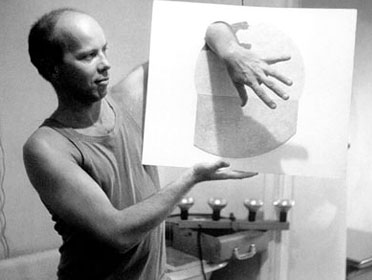Biografia e Critica di RAY JOHNSON
torna indietro

Ray Johnson, un rivoluzionario statunitense.
È stato un personaggio chiave nel movimento della Pop Art. Primariamente un collagista, Ray Johnson è stato anche un precoce performer e un artista concettuale. Definito Il più famoso artista sconosciuto di New York, è considerato uno dei padri fondatori della Mail Art e un pioniere dell'uso della lingua scritta nell'arte visuale.
In scena negli anni ' 60, il suo lavoro e il modo in cui che ha deciso di distribuirlo (tramite il servizio postale) ha influenzato il futuro dell'arte. Nato a Detroit, Michigan, Johnson ha frequentato il Black Mountain College sperimentale con Robert Rauschenberg e Cy Twombly. Dopo aver lasciato BMC nel 1948, trascorse un po’ di tempo creando arte astratta e poi approdando al Dada con suoi collage che incorporano frammenti di fumetti, pubblicità e figure di celebrità. Johnson spesso rifiutava di partecipare a mostre in galleria e ha preferito creare una rete di corrispondenti di mailing e un nuovo modo di fare arte. Questo metodo di diffusione dell’arte divenne noto come la corrispondenza School di New York e ampliato per includere eventi improvvisati e cene. Johnson infine ritirato da New York a una piccola città a Long Island, dove continuò a produrre la mail art. Nel 1995 il corpo di Ray Johnson fu trovato galleggiante in una baia di Sag Harbor, NY .Le circostanze in cui è morto sono ancora poco chiare.
Ray Johnson
In the high-octane 1960s Pop Art scene, Ray Johnson cast a small shadow amongst colleagues such as Andy Warhol. However, his collage work (which he dubbed "moticos"), and the way he decided to distribute it (through the postal service) influenced the future of mixed media art, as well as the mail art movement. Born in Detroit, Michigan, Johnson attended the experimental Black Mountain College with the likes of Robert Rauschenberg and Cy Twombly. After leaving BMC in 1948, he spent some time creating abstract art, and then took on the influence of Dada with his collages incorporating comic strips, advertisements and celebrity figures. Johnson often refused to participate in gallery shows and started mailing his art to a network of correspondents, telling them to add to his creations and then return them. This method of disseminating art became known as the New York Correspondence School, and expanded to include impromptu events and dinners. When Johnson did show his artwork, he was represented by the dealer Richard Feigen, with whom he battled over the nature of the art market. Johnson eventually withdrew from New York to a small town on Long Island, where he continued to produce mail art. In 1995 Ray Johnson’s body was found floating in a cove in Sag Harbor, N.Y. The circumstances surrounding his death are unclear, although some speculate that this final act was also his final performance









